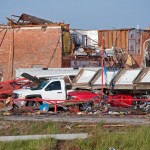This particular launch is nearly two-decades in the making. As early as 2005, Musk hinted at plans to build a giant rocket codenamed “BFR”.
Though the precise plans for the vehicle have changed over time, its purpose has remained the same: landing people on other worlds and fulfilling Musk’s dream of a human settlement on the Red Planet.
“Starship is the first vehicle that is really able to execute on Musk’s vision of making humanity multiplanetary,” said Caleb Henry, director of research at Quilty Analytics, a space consulting firm. “So in a way it’s all been building to this point.”
Once it becomes operational, Starship will be the most powerful rocket humanity has ever built, capable of generating 16.7 million pounds of thrust at liftoff and carrying gargantuan payloads to Earth orbit and beyond. Its power and size makes it a critical part of SpaceX’s future, with the capability of launching massive satellites and large crews of spacefarers. Nasa has plans to use the rocket as part of its own strategy to return to the moon, after awarding SpaceX a $2.9-billion contract to help the agency get there. Starship is also designed to be fully reusable, unlike any rocket ever built before. SpaceX says that will make its operation relatively inexpensive.
All of this means high stakes for Monday’s launch. Before any of these big dreams can happen, SpaceX needs to prove that Starship can actually fly.
“We really need to fly this vehicle to understand it,” Gwynne Shotwell, SpaceX’s president, told a group of reporters in February at a space industry conference.
The Starship System
Standing at more than 120 metres or 394 feet tall, Starship is a behemoth, bigger than the Saturn V rocket that took astronauts to the moon in the 1960s and 70s and Nasa’s Space Launch System that performed its first test flight in November. It’s also destined to be the most powerful, able to lift between 150 to 250 tonnes of cargo to Earth orbit. SpaceX’s most powerful rocket in operation at the moment, the Falcon Heavy, can only carry 64 metric tons to orbit. Starship will allow heavier payloads, like SpaceX’s new, larger Starlink satellites, to make it into space. Elon Musk has also said it could carry up to 100 passengers at once.
The Starship system consists of two primary components: a giant rocket booster and a spacecraft to house space-bound cargo and people.
The booster, known as the Super Heavy, is the large cylindrical rocket body that sits at the bottom of the system when fully stacked on the launchpad. At liftoff, 33 of SpaceX’s new methane-fuelled Raptor engines are designed to ignite simultaneously, providing the immense power necessary to get such a heavy load out of Earth’s atmosphere.
The bullet-shaped Starship spacecraft itself sits on top of the Super Heavy booster. Its multifunctional abilities make it unlike any other space vehicle ever created. It can operate as a crewed spacecraft, crewed lander, propellant tanker and satellite dispenser.
Both of these pieces — Super Heavy and Starship — are designed to come back to Earth and land intact on the surface. However, their landing techniques are a bit unconventional: Two giant mechanical arms will extend outward from the launch tower the rockets took off from and “catch” the vehicles before they ever touch the ground.
It’s extremely complicated architecture, much of which has been untested in flight.
“This is truly a flight test,” Shotwell said to reporters. “And the real goal is to not blow up the launch pad. That is success.”
The Test Flight
No people or cargo will be on board for Starship’s first test flight.
On Monday, during a window that begins at 7 a.m. local time, SpaceX will attempt to launch Starship from the company’s Starbase facility in Boca Chica, Texas, where the company has been mass producing prototypes of Starship for the last five years.
At a little less than three minutes after launch, the Super Heavy booster will separate from Starship and fall back to Earth for a controlled landing in the Gulf of Mexico. There, it will sink to the ocean floor, with no plans for recovery. Testing Super Heavy’s reusability will come in later tests.
Once separated from Super Heavy, Starship will ignite its own engines, propelling Starship deeper into space where it will reach near orbital speeds. About nine and a half minutes after launch, Starship’s engines will cut off, and the vehicle will cruise around the Earth — reaching a peak altitude of roughly 146 miles, well into space.
Starship won’t do a full orbit around the Earth. About 140 miles off the coast of Hawaii, the vehicle will come back through the planet’s atmosphere and splash down in the Pacific Ocean.
This wonky test is meant to prove a few key things: that Starship and Super Heavy can separate from each other as planned and that Starship is capable of reaching orbital velocities and then returning back to Earth.
The Long Road to Starship
The launch will be the most important and complicated test of Starship by far. Between late 2020 and spring of 2021, SpaceX conducted a series of high-altitude test flights, sending prototypes of the Starship spacecraft up to heights of 32,800 feet up and then attempting to land them back down on the Earth again. Only one of those prototypes successfully landed intact without exploding. This will be the first in-flight test of the Super Heavy booster.
Ever since SpaceX started developing Starship in earnest in 2018, the launch has always seemingly been on the horizon, with the company blowing past most of Musk’s aspirational launch deadlines. The company also had to wait as the Federal Aviation Administration conducted a review of Starbase to determine the environmental effects of the expanded facility. In June 2022, the agency said that SpaceX would need to implement 75 mitigation measures to lessen its impact on the area. Finally on April 14, the FAA gave SpaceX the greenlight to launch Starship from Boca Chica.
Now that the licence has been granted, SpaceX can launch Starship whenever it is able. And it’s going to need to get moving, since SpaceX already has a number of major trips planned for Starship — from launching Nasa astronauts and tourists to launching all manner of satellites and cargo.
“I’d love to be able to do 100 flights of Starship next year,” said Shotwell in February. “I don’t think we will do 100 flights of Starship next year, but maybe 2025, we will do 100 flights.”




















 Become an Insider
Become an Insider
Comments - Please login in order to comment.